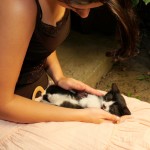Researchers at the University of Minnesota found that people without felines were 30 to 40 percent more likely to die of cardiovascular disease than those without cats. No protective effect of dogs as domestic pets was observed.
Over 4,000 people were surveyed about pet ownership and risk factors. Dr. Adnan Qureshi, stroke expert at the University, said of the cat-dog differential, “We don’t understand this completely – it’s probably not a coincidence.”
I think we can help answer this phenomenon pretty easily.
Cats are creatures of peace and tranquility. They sleep on average 16 hours a day, they are generally quiet and they purr. They follow us around like we’re the pied piper, quietly observing us as we go about our daily activities. They force us to stay on the couch a bit longer as they purr away on our laps. Many have an uncanny sense of when we’re arriving back home, waiting in the window sill until we appear, then meowing and bumping up against our legs with a friendly hello.
Some are very conversational, wanting to tell us how their day went. Their meows are generally very pleasant and sweet. If they are hungry they tell us politely. If they are sick, their observant humans will know by the change in their habits or behaviors, but not because they complain.
These are just some of the ways they affect our lives in a calming, positive way.
So……give your favorite feline a big hug and enjoy them every minute you can! You may just add some years to your life in the process. 


